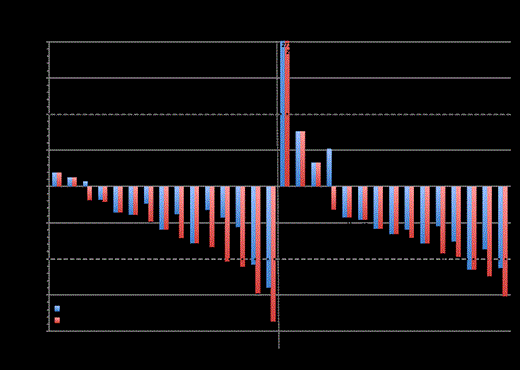Abstract
Abscopal effects, systemic tumor regression following localized therapy, are induced by radiation therapy and augmented with intratumoral immunostimulation. Based on a preclinical lymphoma model, we previously investigated low-dose immunostimulation with a Toll-like receptor 9 (TLR9) agonist in combination with fractionated, low-dose radiation therapy in relapsed/refractory NHL (NCT00185965) and Mycosis Fungoides (NCT00226993). In an attempt to improve the potency of the immune responses and the rate of clinical responses, the dose of CpG was increased 3-fold and enrollment broadened to include treatment-naive as well as relapsed/refractory low-grade lymphoma (NCT00880581). We treated 15 treatment-naive patients and 15 relapsed/refractory patients with follicular lymphoma using low-dose radiotherapy to a single tumor site followed by 18mg of the C-G enriched, synthetic oligodeoxynucleotide (CpG) TLR9 agonist, PF-3512676 injected at the same site, with injections repeated 10 times weekly. Clinical responses were assessed at distant, untreated tumor sites. Immune responses were evaluated by measuring T-cell activation after in vitro re-stimulation with autologous tumor cells. The in situ vaccination with escalated-dose CpG was well tolerated with 16 cases of grade 1 to 2 local or systemic reactions including 2 cases of possibly-related autoimmune disease and no treatment-limiting adverse events. Among treatment-naive and relapsed/refractory patients, four and three patients, respectively, had partial responses with median duration of response of 29 and 12 weeks, respectively. Two and four patients, respectively, had stable disease of duration greater than one year with median time to best clinical benefit among patients with a response or stable disease of 31 and 12 weeks. The range of time to best response was broad, from 10 to 184 weeks (see Figure). Median progression-free survival was similar among treatment-naive and relapsed/refractory patients, at 41 and 35 weeks, respectively, and median overall survival was not reached in either cohort with median follow-up of 2.6 and 3.5 years. Importantly, in response to in situ vaccination, all patients made tumor-specific immune responses within 2 to 4 weeks post-vaccination with the most informative markers being the activation marker CD278 (ICOS) for CD4 T cell response among the CD45RO+ memory subset, and perforin and granzyme B for CD8 T cell responses. Based on the anti-lymphoma activity observed we have recently initiated two Phase I/II dose-escalation trials of a second-generation TLR9 agonist and radiation therapy in relapsed/refractory low-grade NHL and relapsed NHL post-allogeneic transplant (NCT01745354).
Advani:Seattle Genetics, Inc.: Other, Research Funding; Genentech: Research Funding; Janssen Pharmaceuticals: Research Funding; Pharmacyclics: Research Funding; Celgene: Research Funding; Takeda International Pharmaceuticals Co.: Research Funding.
Author notes
Asterisk with author names denotes non-ASH members.


This feature is available to Subscribers Only
Sign In or Create an Account Close Modal